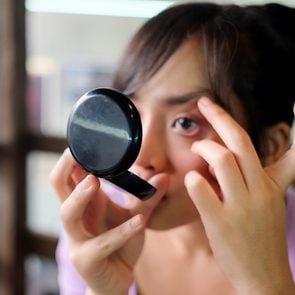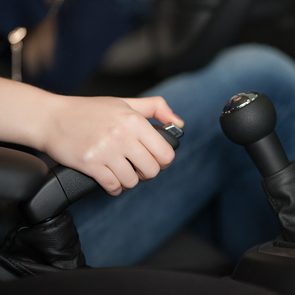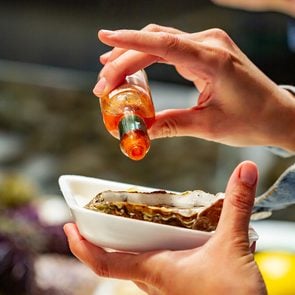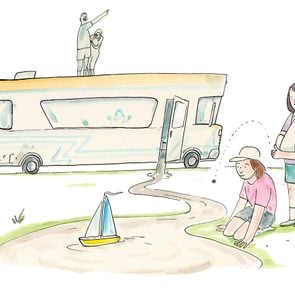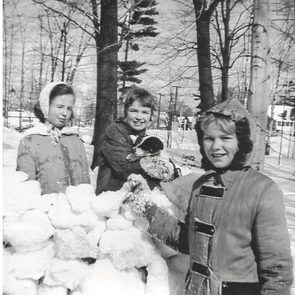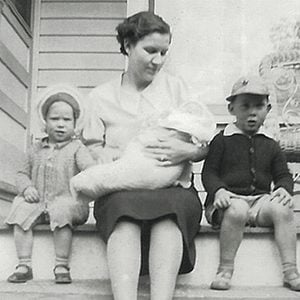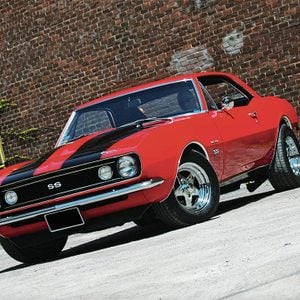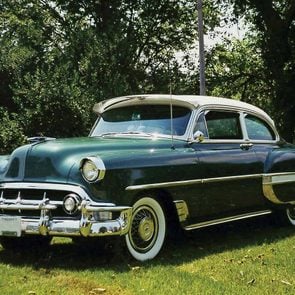
Locating a vacuum leak
A vacuum leak can cause a rough idle, high RPM, poor gas mileage and even trigger a check-engine light. Pros find leaks by filling the engine with smoke and looking for wisps of it. But you can search for leaks on your own with an ordinary spray bottle using this technique.
Start the engine and spray
Scope out all the vacuum lines under the hood. Then start the engine and spray each connection with a light stream of water. If a connection sucks in the water, you’ve found your leak. Then get help at the parts and accessories department of the dealership where you bought your car or local auto centre to replace it, or do it yourself.
Now that you know how to find a vacuum leak, discover what these strange car noises probably mean.
One sunny day in June 2020, Lauren Wells and a few friends set out for a weekend of fun on the Lake Erie Islands. She had reason to celebrate. At just 25, she’d been hired as the head administrator of a nursing home in Sandusky, Ohio.
But the trip wasn’t as carefree as Wells had hoped. On the first night, she felt a shooting pain in her left side, and she had to urinate much more often than usual. She chalked it up to cramps and the fact that she was drinking, and tried to enjoy the rest of her time away.
The following week, however, the pain was still present. Plus, her hands started to feel funny, as if there were a slimy film on them. A friend guessed Wells might be stressed from the new work. “But that didn’t feel right to me,” she says. “I was loving my job.”
The First Auditory Hallucinations
A few days later, as Wells was trying to fall asleep, she started hearing music—a faint elevator-type song that seemed to be coming from outside or the apartment above hers. She looked out the window, expecting to find a street party, but there was nothing. So she went back to bed and tuned it out. But the next night, the music returned. And again the evening after that. Eventually, she wandered the streets, searching for the source. “I was so intent on finding this music,” she says. But she couldn’t pinpoint where it was coming from.
Then things got weirder. The same music seemed to be playing at work and at the bar, and she heard it in the hum of an air conditioner. A friend of a friend, who is an audiologist, explained that people sometimes hear melodies in mundane noises. That comforted her—but not for long.
About a week after the music began, Wells was in Perrysburg, a small Ohio town where she used to live, visiting friends and clearing out her old apartment. One night, she heard seagulls squawking outside her bedroom window. “There are no seagulls in Perrysburg,” she says. It didn’t seem like the audiologist’s theory could explain sudden squawking in an otherwise silent bedroom. “Up until then, I didn’t think I was hearing things that weren’t there,” she says. “But when I heard seagulls, I was like, ‘Something is wrong with me.’”
Unable to sleep, Wells drove herself to the emergency room. The nurses ran some routine tests, but everything came back normal, so they sent her home with lorazepam, an anti-anxiety medication, and a referral to a psychiatrist.
Later that week in Sandusky, during a work meeting that Wells was supposed to be leading, she suddenly spaced out, confused and unable to speak. Concerned, her colleagues—a room full of nurses—called an ambulance. By the time she arrived at the local hospital, she was back to herself. The episode had made her doubly sure something was up, so she called her father, Brad, and voluntarily admitted herself into the psych ward, where doctors put her on a number of medications, including lithium and ziprasidone, an antipsychotic used to treat schizophrenia.
When Brad arrived at the hospital, his daughter didn’t seem like herself. (Wells remembers very little from this point on.) One moment she was acting aggressively with her nurses; the next, she was flirting with them. She was calling her relatives hundreds of times a day, and she wouldn’t sit still during MRIs and EEGs. Then something more troubling happened: she had a seizure. Her doctors rushed her to the ICU, where she was placed on anti-seizure meds.
Unsure what to do, Brad called a family friend who was a psychiatrist and explained the situation. “It’s a really rare bird,” the psychiatrist advised, “but have them look into anti-NMDA receptor encephalitis.”
A Rare Condition
The neurological disease, which causes inflammation in the brain, affects only about one in 1.5 million people and wasn’t even identified until 2007. Brad had never heard of the condition, but when he looked it up online, he realized that his daughter had all the symptoms. All throughout that day, he pushed the hospital to test for it. Wells’ doctors pushed back. The condition is so uncommon that they’d never even seen a patient with it before. But Brad wouldn’t relent. By the following day, they started to believe him.
That afternoon, Wells’ team referred her to the neuro intensive care section at the nearby Cleveland Clinic, where Dr. Joao Gomes, the head of the department, suspected the psychiatrist that Brad had consulted might be right about anti-NMDA receptor encephalitis. But Gomes had a hunch that this wasn’t the whole story. The condition usually has an underlying cause, often testicular or ovarian cancer, so he ordered an ultrasound. Brad was shocked that his daughter, who was otherwise healthy until earlier that summer, could not only have a neurological disease but also cancer. But tests proved that Gomes was right. Wells had a tumour on her ovaries.
With that discovery, Gomes began piecing together the intricate puzzle that explained Wells’ bizarre medical history. To start, the pain in her side and frequent urination were a result of the tumour. Furthermore, her body had started producing antibodies to fight the cancer. “Unfortunately, in Lauren’s case,” says Gomes, “the antibody not only tried to attack the cancer, but it had some cross-reactivity with her NMDA receptors.”
NMDA receptors are channels in the brain that affect memory and behaviour—and that happen to have similar structures to the cancerous cells Wells’ body was trying to fight.
“That’s what produced her symptoms,” says Gomes. The music, the seagulls—they were all auditory hallucinations.
The Treatment
A spinal tap, which proved that Wells had the aforementioned antibodies, confirmed Gomes’ hypothesis. But that was hardly the end of Wells’ ordeal. In order to suppress her immune system and remove the offending antibodies, the Cleveland Clinic team treated Wells with steroids; new antibodies known as immunoglobulin; and plasmapheresis, a process that filtered her plasma and replaced it with donor plasma. They also surgically removed the tumour and put Wells through chemotherapy, which would last for several months.
The treatment ravaged Wells’ body. When she woke up after roughly two weeks in a coma, she couldn’t walk, she struggled to find the right words when she tried to speak, and she was often confused. “I didn’t even know why I was there,” she says. “I had no idea that I had undergone surgery until I saw the scars on my stomach.”
Week by week, she improved, first in inpatient rehabilitation and then in months of outpatient physical, occupational and speech therapy.
By April 2021, about six months after she left the Cleveland Clinic, Wells was cancer-free. Among anti-NMDA receptor encephalitis patients, there is a 10 to 25 per cent chance of relapse within two years, so Wells is keeping a close eye on her health, watching for the return of her symptoms. After briefly living with her parents, Wells moved into her own place again and started working at a new job at a nursing home in Cleveland—she decided it would be best to avoid the stress of her old administrative position. She remains thankful for her father’s advocacy—and stubbornness—as well as the recovery support from her mom and friends. “Who knows how long I would have been dealing with this if not for them,” she says.
Next, read the story of the Toronto teacher whose back pain was a mystery—until the CT scan picked up something strange.
Dishwashers are great time savers, as long as they’re working properly. Growing up in a house where every dish was washed by hand, I have a particular appreciation for these miraculous machines. Trouble is, like most complex time-saving devices, they occasionally fail.
Sometimes these failures are big, and obvious, like your dishwasher not actually cleaning dishes. Other times they’re smaller, but still hard to ignore. White streaks on dishes after a wash cycle is one way your dishwasher might let you down.
Why are there white streaks on my dishes?
There are a couple of reasons why you might be seeing white streaks or residue on your dishes after a wash cycle, and it comes down to the type of residue you’re seeing.
- Dry residue that wipes away easily: Chances are this is a salt residue left behind by your dishwasher. Many dishwashers have a built-in salt container that introduces salt to the water and detergent mixture to soften hard water. If you add too much salt to the container, too much salt will end up in your dishwater. In this situation, white salt streaks could easily appear on your dishes and cutlery.
- Dry residue that doesn’t wipe away easily: Is your household water supply known for being rich in minerals (AKA hard water)? If so, white streaks left on your dishes after a cycle in the dishwasher could be limescale buildup. I’m all too familiar with this problem since my own household water comes from a drilled well and we live on an island made of limestone. Limescale streaking on our dishes is nothing new. Luckily, it’s not too difficult to remove. Just drizzle a little white vinegar on the dishes and scrub the streaks. If the vinegar works, limescale is almost certainly the problem.
- Fatty, greasy residue: Some homeowners report creasy white streaks of fat left on their dishes after a cycle—gross! If this happens to you, chances are your water isn’t hot enough to fully melt and wash away the fat left on your dishes.
Is white residue on dishes harmful?
None of the common types of white streaks on dishes described above are dangerous. Salt residue, limescale buildup and residual grease are all harmless. You could ignore them if you choose, and suffer no ill effects eating off of white-streaked dishes. That said, I don’t recommend ignoring these symptoms. Even though the white streaks won’t hurt you, they usually indicate a problem with your dishwasher that could get worse if you don’t address it.
How do I stop white residue from getting on my dishes?
- For salt residue streaks: Add less salt to your dishwasher. In fact, if you don’t have particularly hard water, you don’t need to bother using salt at all.
- For limescale streaks: To remove limescale, clean your dishwasher with vinegar. Fill a bowl with 1 cup of distilled white vinegar and place it in your washer’s top rack. Run a regular wash cycle with no other dishes in your washer. Chances are this will remove all the limescale streaking. If it doesn’t, repeat the process. When the limescale is gone, run one more regular cycle to flush any remaining vinegar from your dishwasher.
- For fat residue: Try increasing the temperature your dishwasher is set to. Most dishwashers have a main wash cycle temperature of 120 to 140ºF (50 to 60ºC), then a final blast of around 150ºF (65ºC) to remove any remaining grime. Double-check your dishwasher is connected to a hot water pipe supplying water around 120ºF (50°C).
Now that you know what’s causing those white streaks on your dishes, find out the surprising ways you’re shortening the life of your dishwasher.

With a long and successful history, this team knows how to win. They were established back in 1995 along with the Vancouver Grizzlies as part of the NBA’s expansion into Canada and have been beloved ever since by Canadian basketball fans nationwide. The Raptors play their home games at Scotiabank Arena located in downtown Toronto and are currently a part of the Atlantic Division and competes in the Eastern Conference. Nick Nurse, the only Toronto Raptors coach to win an NBA Championship, currently leads Raptors games as the head coach of the team.
How To Buy Toronto Raptors Tickets

Buy tickets for home and away games here.
What makes Toronto Raptors tickets popular is the solid play from the team’s core group of players. Fred VanFleet, Chris Boucher, Gary Trent Jr., Pascal Siakam, O.G. Anouby, Thaddeus Young, and Scottie Barnes are some of the key players that have been instrumental in helping the Toronto Raptors reach their current success. Historic players such as Chris Bosh, Vince Carter, Kyle Lowry, Kawhi Leonard, and Tracy McGrady have also been a part of the Toronto-based team’s winning legacy.
See the Toronto Raptors Play in Upcoming NBA Games
There’s nothing quite like a live Toronto Raptors game — the atmosphere, the energy, and of course, the basketball. The Canada-based NBA team has started the 2022-2023 season off with a bang, playing some of its best games in recent memory.
With a current standing of 21 wins and 27 losses as of late January, the Toronto Raptors are neck-and-neck with top Eastern Conference teams. The team trails just behind some of the Toronto Raptors’ biggest rivals in the NBA, including the Atlanta Hawks, the Indiana Pacers, and the New York Nicks. Following closely are the Chicago Bulls, the Washington Wizards, and the Orlando Magic, making this Toronto Raptors season a must-watch.

Upcoming Raptor games are sure to be unforgettable. With exciting matchups against some of the NBA’s powerhouses, like the San Antonio Spurs on February 8th, the Utah Jazz on February 10th, the Detroit Pistons on February 12th, and the Orlando Magic February 14th, Toronto Raptors fans won’t want to miss a second of the action. If these games continue to keep the Raptors in the top 10 of their conference, the team could be on its way to another successful postseason run.
How to Get Cheap Toronto Raptors Tickets
Toronto Raptors ticket prices can vary depending on who they are playing, when the game is being held, and where the seats are located on the Toronto Raptors seating chart. As the game gets closer, prices for Raptor tickets will typically go up. So if you’re looking for a great deal, it’s a good idea to buy Raptors tickets as soon as they go on sale — especially if it’s a home game at Scotiabank Arena in Toronto.
Tickets to upcoming Toronto home games at Scotiabank Arena typically start at around $40 for basic upper-row seating, but these cheap Raptors tickets don’t offer a lot when it comes to views. Courtside seats, on the other hand, can be priced well into the thousands. A great view can be affordable, however, with lower-level seats selling for as low as $93 — including all fees. This is because season ticket holders often offload their seats at a hefty discount, giving other enthusiasts an opportunity to buy Toronto Raptors tickets at a fraction of their original price.

If the Raptors make it to the playoffs in 2023, those Toronto Raptors ticket prices will be significantly higher. The team’s first playoff appearances could be scheduled for April, and fans should be able to start buying Toronto Raptors tickets a few weeks before the games begin. In the past, Toronto Raptors playoff tickets have been priced at around $200, but fans seeking a closer view can expect to pay much more. While cheap Toronto Raptors tickets can be harder to find in the postseason — particularly during the NBA finals — the availability of discounted fan-to-fan postseason tickets means it’s certainly possible to find Raptors tickets for these major events without breaking the bank.
No matter where or when this Toronto-based NBA team plays this season, you can be sure that basketball fans everywhere will be keeping an eye on its progress. Watching the Toronto Raptors play at home or on the road is an incredible experience, and with the right tickets and a close eye on the schedule, Raptors enthusiasts can enjoy every second of it. However, fans should also be mindful of where they’re buying their Toronto Raptors tickets. Foreign-owned marketplaces are known for charging exorbitant service fees — and hiding them until checkout — when selling Toronto Raptors tickets. Trusted Canadian Raptors ticket marketplaces like VIP Tickets Canada offer transparent fee structures and secure purchases, allowing Raptors enthusiasts to enjoy professional basketball at the best prices. VIP Tickets Canada is one of the nation’s largest privately owned ticket marketplaces, guaranteeing competitive, all-in pricing and a wide selection of seats for Toronto Raptors games.

The Toronto Raptors have a lot of work ahead of them in 2023, and the team’s upcoming games will be crucial in determining the team’s success this season. Players like Vince Carter, Chris Bosh, and Kawhi Leonard have proven in the past that the Toronto Raptors are capable of achieving great things, and with a healthy roster of fresh players and an enthusiastic fan base, this season could be another one to remember. The best seats in Scotiabank Arena are always going to sell out fast, so Toronto Raptors fans should make sure they keep an eye on the schedule of events. By securing the best deals on tickets, NBA enthusiasts can ensure that they won’t miss a single play when the Toronto team hits the court.
How Much Are Toronto Raptors Tickets?
Toronto Raptors tickets start at $40, but average $146 to see a game live. The best seats can cost up to $3323.
Who Are The Toronto Raptors Playing?
Raptors vs 76ers
Raptors vs Blazers
Raptors vs Bucks
Raptors vs Bulls
Raptors vs Cavaliers
Raptors vs Celtics
Raptors vs Clippers
Raptors vs Grizzlies
Raptors vs Hawks
Raptors vs Heat
Raptors vs Hornets
Raptors vs Jazz
Raptors vs Kings
Raptors vs Knicks
Raptors vs Lakers
Raptors vs Magic
Raptors vs Mavericks
Raptors vs Nets
Raptors vs Nuggets
Raptors vs Pacers
Raptors vs Pelicans
Raptors vs Pistons
Raptors vs Rockets
Raptors vs Spurs
Raptors vs Suns
Raptors vs Thunder
Raptors vs Timberwolves
Raptors vs Warriors
Raptors vs Wizards
Check out the Raptors Schedule or a Raptors game for a fun-filled game.
*Use code “digest” to find these prices. Prices found 11/22/22 and include all fees at checkout.
While you might assume that the act of fastening your seatbelt means you’re safe no matter where you’re sitting in the car, the truth is more complicated. Weirdly, the safest spot to sit depends on your age.
In research throughout the years—including studies at the University of Buffalo, the Children’s Hospital of Philadelphia, and other findings, investigators have found that children younger than eight years old had the lowest risk of death while sitting in the rear seat; the risk increased slightly if they were between the ages of nine and 12. (By the way, all the statistics refer to occupants who are properly belted in to approved seating.) From ages 13 to 54, researchers found no difference in risk of fatality in the rear seats versus the front seats. In research involving older cars and all age groups, the overall safest spot in the car seemed to be the middle back seat.
However, when researchers singled out people over 55 in newer model cars, the back seat was actually more dangerous than the front. “That doesn’t mean that the rear seat in newer vehicles is less safe than in older model vehicles,” said Anne McCartt, senior vice president of research with the Insurance Institute for Highway Safety/Highway Loss Data Institute. “The risk of fatal injury for rear occupants is similar across all of the model years we examined. Instead, the disparity reflects the fact that the front seat is getting safer.”
Seatbelts are still the most important—and controllable—risk factor. In numerous studies, people who fail to buckle up are at least eight times more likely to suffer a serious injury. In short, always fasten your seatbelts.
Next, find out why you should never follow a friend when driving.

Dana Small was 11 years old when she knew she wanted to study the brain. Six years earlier, her mother had developed epilepsy. Small watched as a woman she’d known to be quick witted and brilliant struggled to get out of bed in the morning. “That’s what sparked my interest in the fragility of consciousness,” Small says, “which is what led to the brain.”
In 2001, she received her PhD from McGill University, after conducting one of her first and most famous experiments. In it, she gave subjects Lindt chocolates to suck on as their brains were being scanned. The scans revealed that with each successive chocolate, pleasure—or “reward value,” as the study called it—diminished. The parts of the brain that were brought to glowing life by the first chocolate became more and more dim. The study, published in Brain: A Journal of Neurology, was a breakout success. To this day, Small remembers Wolfram Schultz, one of the world’s most prominent neuroscientists, telling her that it was the most comprehensive study yet of motivation in humans. Since publication in 2001, it has been cited more than 1,300 times by other scientists exploring the nature of pleasure, not to mention by an untold number of journalists who use it as proof of humanity’s hardwired and dangerous love of sweetness.
Despite the widespread acclaim, Small often found herself unsure of what the experiment actually showed. Was sweetness simply a superficial pleasure that diminished with continued exposure, the way a song can become boring when overplayed? Or was something deeper going on? Was the brain’s opinion of those chocolates influenced by signals it was receiving from the body and computations it was making about its needs?
It would take years, but those thoughts eventually crystallized, sending Small down a twisting experimental path that would lead to the biggest finding of her career.

Lessons From Sweet-Blind Mice
It began in 2008 at Yale University, where Small had become a professor. Next door to her office, a Brazilian neuroscientist named Ivan de Araujo had been running some odd-sounding experiments with mice that were “sweet-blind”—they had been genetically engineered to lack the ability to taste sugar. Araujo then fed them, of all things, sugar.
Araujo was interested in “post-ingestive” effects. In 1970, a French physiologist named Michel Cabanac ran an experiment and found that sugar water extinguished appetite only if it was swallowed—if people spat it out, their hunger would persist. That meant sugar’s biological interaction with the human body went beyond the tongue. A message, it seemed, was delivered to the brain that said, “Sugar obtained—cancel hunger.” If the sugar water was spat out, however, no such message was sent. This was what led Araujo to do something as seemingly pointless as give sugar water to mice who were incapable of tasting sweetness.
The mice were put in cages with three sippers. One was filled with water, another filled with sugar water, and a third one with even sweeter sugar water. The mice, being sweet-blind, had no idea which was which, so they fumbled between dispensers, licking them all equally and randomly.
But only for a little while. After six days, the mice’s behaviour was no longer random. They were deliberately drinking sugar water. They consumed it with the same frequency and in the same quantity as mice who were not sweet-blind. Somehow, the “blind” mice knew which sipper was which.
Araujo discovered that the brain chemical dopamine, previously thought to trigger the feeling of “wanting,” was keeping a running tally of the energy contained in the food the mice had consumed. With time, dopamine did enough bookkeeping that deep in the brains of the mice, predictions were formed, such as sipper on the left = calories. When those mice became hungry, “wanting” kicked in, compelling them to the sipper with calories, which they drank from, all the while not tasting a thing.
His mice “wanted” calories and ingested them from the sweet sipper until “wanting” turned off. But their desire was never quenched by enjoyment. “We didn’t see the classic liking signs,” Araujo says. There was no paw-licking, no gleeful tongue-poking. The mice were like whiskered little robots.
Araujo followed this study up with one that was even stranger. This time, he used regular lab mice and put them in cages with two sippers; one contained water mixed with sucralose, an artificial sweetener, while the other contained an extremely bitter chemical called denatonium benzoate. The bitter sipper, however, was configured in such a way that when a mouse drank from it, a little burst of sugar would be injected into its stomach. Araujo thus “rewrote” the rules of taste. Sweetness now indicated no calories, while bitterness did the opposite. Once again, the mice behaved like intelligent energy-seeking robots. They gave up on the sweet but ultimately useless sipper and opted instead for the wincingly bitter taste of the denatonium benzoate, as though magnetically drawn to the calories it provided.
The rules of taste, it seemed, weren’t carved in stone. Sweetness may be hardwired, but it is just a cue, a label whose meaning can be overwritten. The stomach wasn’t some dumb and unfillable pit—it was an active participant, sending information to the brain, information that was recorded with each meal and used to make predictions. What the brain ultimately cares about isn’t how food tastes. It cares whether food is useful.

Unexpected Results
Araujo’s findings brought Small’s thoughts back to her Lindt chocolate experiment. What was it exactly, she wondered, that she’d witnessed in the brains of her chocolate eaters? Was it a simple attraction to sweetness fading in those brain scans? Or was it a deeper attraction to calories that was fading to black?
It is a fine and good question, but how do you answer it? How could Small measure in humans what Ivan de Araujo had so exquisitely observed in genetically engineered mice?
This is how: Small created five separate drinks, each with a distinct flavour and colour. She then added a precise amount of the artificial sweetener sucralose, so that each drink tasted as sweet as a drink that contained about 75 calories’ worth of sugar. Finally—this was the key step—she added varying amounts of a chemical called maltodextrin, a simple, high-calorie starch invented in the late 1960s that the subjects could not taste, which allowed her to manipulate the calorie count of each drink while leaving the taste unchanged.
Small had thus created a little arsenal of drinks that tasted equally sweet, but each carried a different energy payload: zero, 37.5, 75, 112.5 and 150 calories. Small gave samples of the drinks to her test subjects so that their brains could “learn” the caloric value of each. Next, she scanned their brains as they sampled each beverage. If she detected any differences in the “wanting” areas of the brain, she knew it would have to be due to the calories and not the sweetness, because the drinks all tasted equally sweet.
It was ingenious. Small had found a way to separate calories from sweetness in human test subjects, and now she would be able to measure which was doing what. Everything about the experiment was perfect, except for one thing: it didn’t turn out at all the way she expected.
Small had anticipated that the highest-calorie drink would trigger the biggest brain response. A hundred and fifty calories are more biologically useful, after all, than zero calories, 37.5 calories and so forth. Yet it was the 75-calorie drink that generated the clearest spike of brain activity. What was going on? If calories were driving the desirability of the drinks, then the 75-calorie drink should have produced less motivational oomph than the 150-calorie drink. But it produced more. If calories had nothing to do with desirability, why would a 75-calorie drink be more desirable than a zero-calorie drink? It made no sense.
The more Small thought about it, however, the more a single number came into focus: 75. The drinks had all been designed to taste as though they had 75 calories’ worth of sugar, and it was the 75-calorie drink that produced the biggest brain response: 75 and 75. Was this more than just a coincidence?
To answer that question, Small moved from the brain to the body and measured how each of the drinks was metabolized. It was a simple experiment. Subjects would enter the lab, consume one of Small’s drinks, then be connected to a machine called an indirect calorimeter, a device that analyzes the heat a person’s body produces and from this can estimate the quantity of calories being burned. It is a textbook response called the thermic effect of food. When the body takes in calories and uses them, it generates heat as a by-product, the same way the engine of a car heats up after it’s been running. The more calories a person consumes, the greater the thermic effect.
That, at least, is what the textbooks say. But that is not what Small found. She can vividly remember the day her laboratory assistant showed her the initial results. “It blew my mind,” Small says. “I knew right away we were onto something new and exciting.”

“Nutritive Mismatch”
A few days earlier, a female test subject, a woman in her 20s, had consumed the 75-calorie drink and was subsequently connected to the indirect calorimeter. On cue, her body produced a little plume of heat, indicating that the 75 calories were being burned.
Days later, the same woman returned and drank the 150-calorie drink and, once again, was connected to the indirect calorimeter. There should have been a gradual uptick in heat production. Her body should have produced more heat with the 150-calorie drink than it had with the 75-calorie drink. Then Small’s lab assistant shared data that seemed almost impossible: the indirect calorimeter measured nothing. It was as though the woman had not consumed a single calorie.
The findings were so odd Small did the experiment again, but the results did not change. Over time, a distinct pattern had emerged: when people consumed the drinks in which the sweetness and calories were not in sync, the calories those drinks delivered would not be properly metabolized. Small calls the phenomenon “nutritive mismatch.” The maltodextrin would splash into their stomachs, where enzymes would convert it into sugar, and the sugar would be absorbed into the blood. But then, oddly, it wouldn’t get burned. Like a film of gasoline floating atop sea water, the sugar just circulated in the blood. When the drinks were “matched,” on the other hand—when the level of sweetness correctly indicated the caloric payload—the calories were burned as expected.
Small’s research journey had taken a 90-degree turn. By attempting to discern what it was about sweet foods that made them desirable, she had unexpectedly discovered something more fundamental. Sweetness wasn’t just some enjoyable but arbitrary taste sensation. It was a metabolic signal, the first spark in a string of biochemical processes by which sugar is turned into energy. Sweetness was like the trumpeter at the castle gates. It heralded not only the arrival of calories but the specific quantity and began making arrangements for how they would be used.
When sweetness and calories match, it all hums along: calories are burned, the brain registers it, and the brain remembers. But when there was an unexpected variance between what the tongue sensed and what the stomach received, the entire metabolic process seemed to shut down. “It’s like the system just threw up its hands,” Small says, “and didn’t know what to do.”
Did nutritive mismatch have long-term consequences? This question prompted Small’s next study, which looked for a hallmark of diabetes called insulin sensitivity, a condition in which cells no longer respond properly to this crucial hormone. She tested drinks with sugar, drinks with no calories, and drinks where sweetness and calories were mismatched. Once again, the results were as amazing as they were alarming. The mismatched drinks—and only the mismatched drinks—impaired insulin sensitivity.
Finally, Small fed mismatched beverages to teenage boys and girls. This was a particularly relevant investigation because adolescents are in a period of heightened body and brain development and so have an outsize calorie appetite, which is one reason teens drink a lot of sugary beverages. The study had barely even begun when Small and her team drew blood from three subjects and discovered, to their great alarm, that two had already become prediabetic. An ethics board reviewed the results and deemed the health risk to be so great that it would be unethical to continue.

A Brief History of Calories
If the thought of spiking blood sugar and prediabetic teenagers alarms you, there is more bad news. Those drinks didn’t even taste good. The highest-scoring beverage inched above “like slightly” but didn’t crack “like moderately.” Small’s brain scans showed plenty of cerebral action, but “liking” wasn’t invited to the party. It was “wanting.” Her beverage-drinking volunteers were like those sweet-blind mice—drawn to consume drinks they did not particularly enjoy.
It makes one wonder: where did this idea that obesity is an excess of pleasure come from in the first place? This is the root of a long-standing stigma against obese people. They indulge themselves to excess. They are too selfish to say, “I may want more, but enough is enough.”
Obesity, the experts keep telling us, is caused by an overabundance of “highly palatable foods”: pizza, ice cream, chicken fingers, cheeseburgers and the like. Lately it has become fashionable to refer to such foods as “hyperpalatable,” the idea being that these ultraconcentrated wallops of sweet and salty calories deliver a hit of bliss so strong it “sensitizes” the brain, just like addictive drugs.
If only life were that simple. It is easy to paint calories as humanity’s enemy, which perhaps explains why we have gleefully been doing so for decades. But to malign the lowly calorie is to fundamentally misunderstand the evolutionary story that brought our species into existence.
Several million years ago, the brains of our evolutionary ancestors were roughly a third the size they are now. Brains are energy hogs. They burn lots of calories. Having a small brain meant our ancestors could survive on a low-calorie, fibrous plant diet. They spent much more of their time foraging and eating, and they had long, slow-moving digestive tracts that were needed to extract nutrients from this kind of diet.
As humans evolved, however, a trade-off took place. Our brains got much bigger, while our guts got smaller and faster. A big brain paired to a small gut meant we had to upgrade to food that packed a bigger caloric punch: fatty meat, nuts, seeds, grains, sweet fruit and the like. Four entirely separate populations of humans—one in Europe, two in Africa and one on the Arabian Peninsula—evolved the ability to digest milk into adulthood, giving them the lifetime ability to consume one of the few sources of fat blended with carbohydrates found in nature.
Eating such a calorie-rich diet brought with it a great advantage: time. We spent less of the day obtaining food. We saved countless hours of needless chewing. Instead, we began to do all the things that make us human: we fashioned tools, erected structures, shared stories, created myths and played games. We invented cooking, which made our rich, easy-to-digest food even easier to digest.
Calories made humanity possible. Calories are what fuelled our big brains. Our calorie-rich diet didn’t reinforce the compulsion to eat; it released us from a food-gripped existence. It gave us the time to do big-brainy things. Just because we require calories does not mean our basic programming compels us to overconsume them, for the same reason that requiring oxygen does not compel people to perpetually hyperventilate.
As we became more advanced, there were even more reasons to refrain from overindulgence. Food had to be shared with other members of the tribe, then the village, then the town, especially with children, whose dependence on adults for resources lasts an eternity compared to that of other species.
Eventually, we reached one of the great landmarks in our species’ development: we figured out how to store food. Eleven thousand years ago, we stockpiled grain in purpose-built facilities that kept it dry and free from rodents so we could eat it weeks and months after harvest. Ancient Egyptians collected honey from their apiaries and stored it in clay pots. Five thousand years ago, Indigenous people living on the Great Plains smashed bison bones into pieces and boiled them in steaming vats fashioned from animal hides. When the rendered fat rose to the top, they scooped it off and blended it with dried meat and berries to make a carb-, protein-, and fat-rich calorie bomb called pemmican.
This innovation brought with it an incredible leap forward in energy efficiency. When calories are stored as fat, a great deal of energy is wasted just hefting all that extra weight around. But when food energy is preserved outside the body—in clay pots, in granaries—you achieve far greater efficiency.
Storing food, however, also required an essential mental capability: the ability to resist eating it. Ancient Native Americans didn’t sit there for days at a time stuffing themselves full of pemmican until none was left. They feasted after the bison hunt, but they retained the ability to set aside enough for the brutal winter yet to come. There was an evolutionary fitness advantage in being able to say, “I will eat this later.” If we didn’t have that ability—if we really were slaves to our unending appetite for calories—the human species would have died off long ago.
All of which leaves us with the following paradox: why were more primitive humans able to resist consuming too many calories but advanced humans are not? In Dana Small’s research, we at last have the beginning of an answer.
Ever since organisms began sensing food as it entered their body, the information they gathered was reliable. This is why the ability to taste evolved in the first place. No creature has 40 minutes to sit and digest a meal so its brain can figure out if it should keep eating. It is much more efficient to take a reading as the food comes in. The ability to sense food is so crucial, in fact, that more DNA is devoted to systems that sense the taste and flavour of food—the nose and the mouth—than any other part of the human body. Tasting food engages more grey matter than any other activity.
This system is designed for accuracy, but it evolved in an environment in which food provided the senses with accurate information. Small’s research shows what happens when that changes: when the food we eat tells the brain a nutritional lie, the system fails. Calories enter the blood but are not burned. “If sweeteners are disrupting how carbohydrates are being metabolized,” Small explains, “then this could be an important mechanism behind the metabolic dysfunction we see in diets high in processed foods.”
To make matters even worse, we appear to be entering a golden age of nutritive mismatch, and ironically, it is in large part due to the widespread panic over sugar. To a food company, nothing could make more sense than blending sugar with artificial sweeteners. Both the calories and the amount of “sugar” appearing in nutritional info panels decreases, but the sweetness stays constant and the food or drink remains as tasty as ever. Creating nutritive mismatch is, simply, good for business. There is mismatch popping up all over the food and beverage aisles.
So here we have found a fundamental aspect of food and eating that has changed: the sensed nutritional value. For as long as humans and their ancestors have existed, the taste of a calorie matched the energy it delivered. In the span of just a few decades, that has changed. Calories don’t “mean” what they used to.
We have tampered with the very way the brain perceives food. This is what has set so many of us on a path to weight gain. We changed food, and it changed us.
Excerpted from The End of Craving. Copyright © 2021, Mark Schatzker. Published by Avid Reader Press an imprint of Simon&Schuster. Reproduced by arrangement with the Publisher. All rights reserved.
Now that you know why you’re craving chocolate, find out 25 ways sugar is making you sick.
While it may not be one of your body’s most attractive features, earwax (medical term: cerumen) is part of its natural defenses. Secreted by glands in your ear canals, it cleans and protects by trapping invading dirt and dust and preventing the growth of bacteria.
Thanks in part to the motions of chewing and talking, older cerumen makes its way out of the ear, where it falls out or washes away, bringing germs and other foreign particles with it and making room for the fresh wax that’s been created.
Normally, proper wax management boils down to letting this process happen naturally. If wax is visible on your outer ear, you can gently clean it with a cloth.
However, you shouldn’t try to remove it from the inside. Don’t be tempted by cotton swabs, since “putting anything in the ear risks, at best, pushing the wax back in or, at worst, damaging delicate skin,” says Dr. Shakeel Saeed, a professor of otology and neuro-otology at the University College London Ear Institute in the U.K. You could even perforate your eardrum or dislocate the bones of the inner ear.
Your ear canal may become obstructed by wax if the glands in your ears produce an excessive amount (some just do), if your body can’t manage to clear it out effectively or if you accidentally jam it in further during a misguided cleaning attempt. Symptoms of blockage can include earache, tinnitus, decreased hearing, dizziness or even coughing, since the buildup can push against nerves and trigger the cough reflex.
A doctor, who will have professional tools and methods, can achieve earwax removal far more safely than you could. Another reason why it’s best to visit a GP: it may not be cerumen that’s causing your symptoms but rather an infection, age-related hearing loss, an injury from pressure changes or one of many other problems. (Learn to spot the signs of hearing loss.)
If earwax blockage is a frequent occurrence, your doctor may recommend cleanings and the use of earwax-softening drops. Commercial formulas are available, but mineral oil or olive oil can also do the job. If a hearing aid is contributing to your recurring problem, says Saeed, you can try “removing it several times per day for an hour or so, to see if that helps.”
Next, find out what your earwax says about your health.
I am a fan of high-tech safety technology that helps us avoid mishaps before they happen. So I find myself wondering if having input from the sensor technology incorporated into today’s “self-driving” cars would have influenced a key decision made by my son, Paul, a few years ago.
He had flown home to Saskatoon from Toronto and decided to purchase and drive an older secondhand Cougar (above) to his new job near Weyburn, about 110 kilometres southeast of Regina. He had planned to turn left onto a secondary gravel road at the four-hour point of the drive, which he did, but soon realized that he’d turned “one road too soon.” But he wasn’t lost. As he said, “I had the idea that every road in Saskatchewan is part of a grid.”
The road he had turned onto was close to the one he wanted, but was dirt not gravel. And he was not aware that an unusual amount of rain had fallen in the area. The dirt road deteriorated into mud before his eyes, to the point where attempting a U-turn would have caused him to get stuck. So, he powered through the muck and made it to the next turning point, which was, in his words, “An instant regret.” He got stuck in mud up to the door panels.
Making matters worse, his cell phone was out of commission. He walked to a farmhouse where an older couple called their son-in-law who drove over in his truck and they hooked a tow rope to the old Cougar. It didn’t take long to extract the car and the son-in-law hauled it and Paul to the proper grid road, which thankfully was dry. The truck pulled away, leaving a long slick of mud in its tracks. Paul hopped into the Cougar, put it in drive, but couldn’t get a grip! He rummaged in the trunk and found a windshield scraper to knock the clay out of the wheel wells and scrape the tires. The Cougar had the shakes all the way, but finally got Paul to his destination in total darkness, hours late.
The next morning when his new workmates took a look at the plastered-up Cougar, they christened it “Off-Road Mudder” and the nickname stuck.
Imagine though if Ole Mudder had safety sensors onboard that detected colour changes in the surface of the road ahead? Paul would have received an alert about mud ahead and avoided the whole mess altogether.
Next, take a nostalgic look back at what it was like learning to drive on the farm.
Holland, Manitoba, in the mid-1940s is where my story originates.
In winter, southern Manitoba received a reasonable amount of snow and, once it arrived, it usually stayed until spring. In those days, snow was left where it fell except for storefront steps and sidewalks near some homes’ entryways. The main street in Holland, called Broadway, had a gentle slope for about a block-and-a-half, stretching south of the Stewart Avenue intersection, which was named after my grandfather, and north beyond the intersection with S. Railway Avenue. For the most part, it was dimly lit by electric street lamps.
When snow fell, it was soon packed down by cars, trucks, horse-drawn sleighs or foot traffic. In town, Saturday night was the busiest of the week. Like many other small towns on the Prairies in those days, stores stayed open late on Saturday night. Farm families would come to town to get the mail, shop, have a beer or two, take in a movie or just visit.
In winter, they might curl a game or two or let the kids have a skate at the rink. All other weekday nights had very little traffic; as the saying goes, come 5 p.m. the streets were rolled up. This permitted the town youngsters to tote their sleighs and slide down main street, which with its reasonably good slope, was ideal for sledding.
Spirited Hijinks
Most evenings after supper—except Saturday night—many of us would migrate to the top of Broadway with our sleighs. Sometimes we would sit on the sleigh while another friend would give us a hefty running push. Other times we would take the sleigh in hand, dash forward, then plop it down onto the hard snow surface and drop ourselves face-down on top of it. Frequently, a friend who didn’t have a sleigh of their own, or had to share one with a brother, might follow you as you dashed, and he, too, would plop down on top of you in a piggyback manner.
The sleigh I had was built with steel runners and a wooden crossbar handle to steer the sleigh, keeping it to the centre or the crown of the road. Or, we could also assist steering by dragging one toe off to the side onto the snowy road. We could also paddle with our outspread arms onto the road to maintain speed and increase distance. We would usually travel the full length of the run. Often we would have a friendly competition to see who could go the fastest and/or the farthest. To stop in the event that a car was coming down the road or through the intersection, we’d simply roll over onto the snow.
Other sleigh types were designed in a very shallow format with a tow rope and elongated hand holes cut into the wooden side runners; these wooden runners had a round steel rod, shaped to wrap tightly into a groove routed around the ends and bottom of the side runners for a durable, more slippery running surface.
Down we would go, at the end of our run we would turn around and drag our sleighs back up the hill for another run. This went on for a couple of hours—the number of sledders would dwindle the later it became. In winter, darkness fell at about 5 p.m., however, all Sunday afternoon and weekday evenings were fair game. We usually finished by about 7:30 at night.
One peculiar incident I recall involved little Lloydy Elder. The Elder boys had a very shallow sleigh that would accelerate swiftly. Lloydy headed down the hill at full speed with his head tucked down and both arms paddling, not looking where he was headed. Suddenly, a 1920s vintage car with a high clearance entered the scene but Lloydy just kept on going. He passed beneath the vehicle without noticing until he came out the other side, none the worse for wear. Had he raised his head only slightly he would have surely been injured or worse, run over! I don’t recall anyone ever getting hurt. I can’t remember my mother ever having to scold me for coming home late or having to send my older sister Helen over the two blocks to tell me to “get home.” We never really seemed to feel the cold or suffered from frostbite, but we must have, we were just too busy having fun to notice.
Our family moved from the little town of Holland to Lethbridge, Alberta, in August 1948 when I was almost 11. Although this curtailed most of my winter sledding, I still recall the great fun we all had back then.
Next, find out what Prairie life was like during the Great Depression.
My dad—Willy Karl Henrich Buechman—passed away on January 16, 2017, at the age of 90. He was born in Schleswig-Holstein, Germany, and served in the navy during the Second World War, travelling the whole coast of Norway. Because of my respect for him and in memory of him, I purchased a vintage car that I’m sure he would have enjoyed riding in—a 1941 Hudson Deluxe Six.
My “old girl” is 78 years old now and still cruises along with the original engine and body, a “three on the tree” manual transmission and a push-button starter on the dash. The Hudson for 1941 came with two especially interesting features, in addition to its lovely body lines. It features a dual-braking system that Hudson introduced as a safety feature, consisting of hydraulic brakes with a mechanical brake as backup. The car was also the first to offer a hood release under the dash. Another interesting thing I learned about this Hudson model is that the interior was designed by a woman, likely a rare occurrence in the industry back then.
I had the interior seats of my car redone in grey leather, rather than in the original cloth pattern. The engine, however, is the original flat-head six, producing 92 horsepower. The running boards are now constructed of fibreglass, not metal and rubber.
We never owned a car while I was growing up, but this did not stop me from developing a passion for old cars. As a child, I played in some cars from the 1920s and 1930s at a local Supertest garage station about a block away from our house. The garage was owned by the Petznick brothers—Arnold, Albert and Wally—who treated me very well.
I’ve owned my Hudson since November 11, 2017. It was actually delivered to me on Remembrance Day, which I thought was rather fitting. While no means perfect, it drives nicely. There’s no power steering, but it feels like there is!
People tend to stare when they see the car coming; as far as I know, it’s the only one of its kind here in Pembroke, Ontario. Hudson originally advertised this model in 1941 at a purchase price of $675 brand new. It seems that my Hudson spent 25 years in the United States before it made its way to Stratford, Ontario. After purchasing it, I discovered that the Stanley Cup had been driven in it during the 2004 N.H.L. parade in Stratford.
I wasn’t able to attend old-car shows last year, but I’m looking forward to some outings this summer. A special thanks goes out to my wife, Clare, who helped make a childhood dream a reality for me. And, yes, she has ridden in the car. Who knows, perhaps this will be the year she masters driving it!
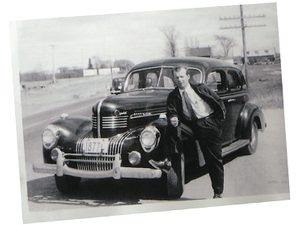
I bought my Hudson on my 60th birthday; I’m sure my father would have approved of my choice, with a sense of pride. A photo of my dad with his foot on the bumper of a 1939 Chrysler New Yorker (above) sits on my dash, a reminder of the respect I have for him, and many great memories. Thanks, Dad, hope you enjoy the ride!
Next, read the heartwarming story of the special memories attached to one woman’s 1930 Cadillac Club sedan.



